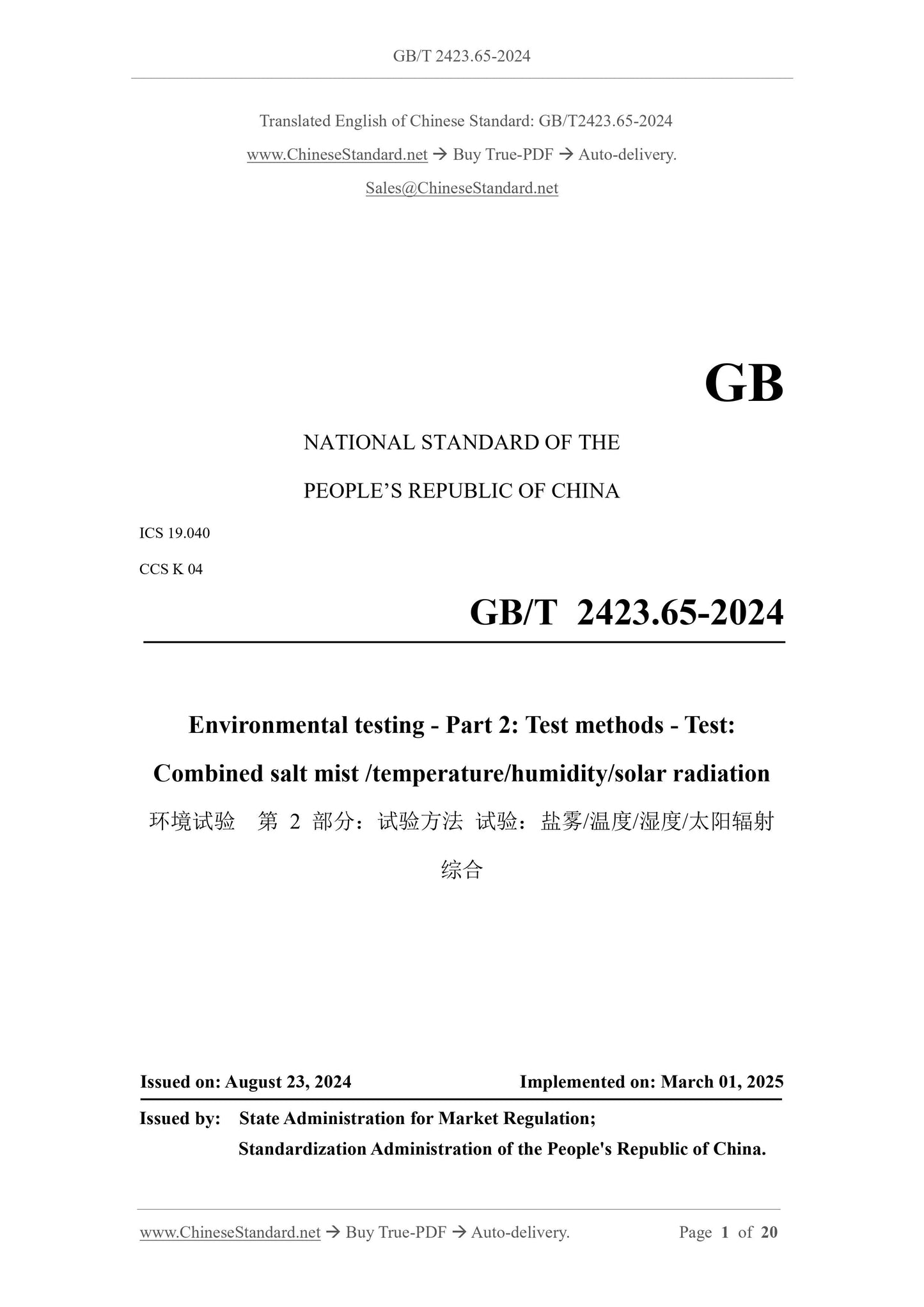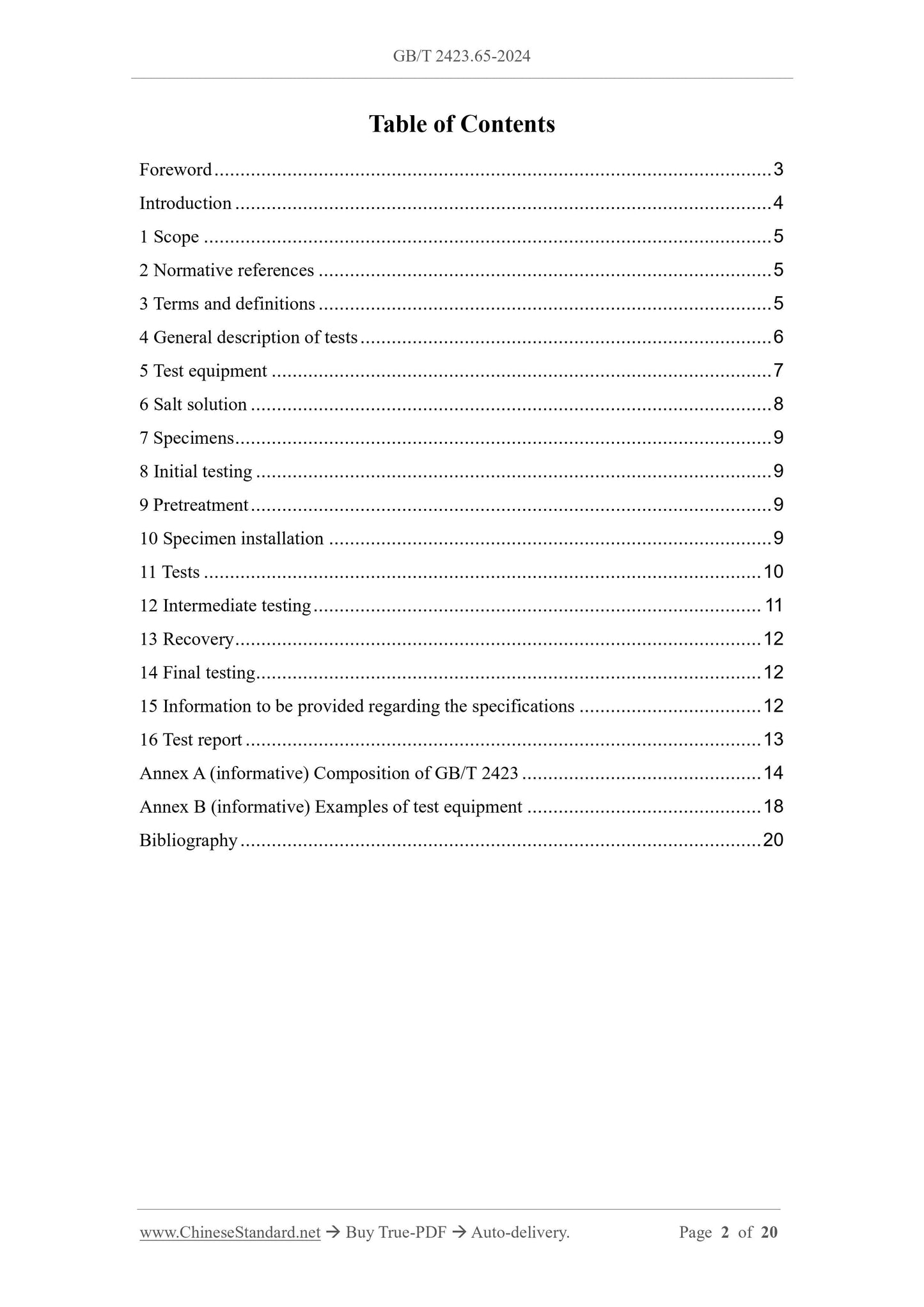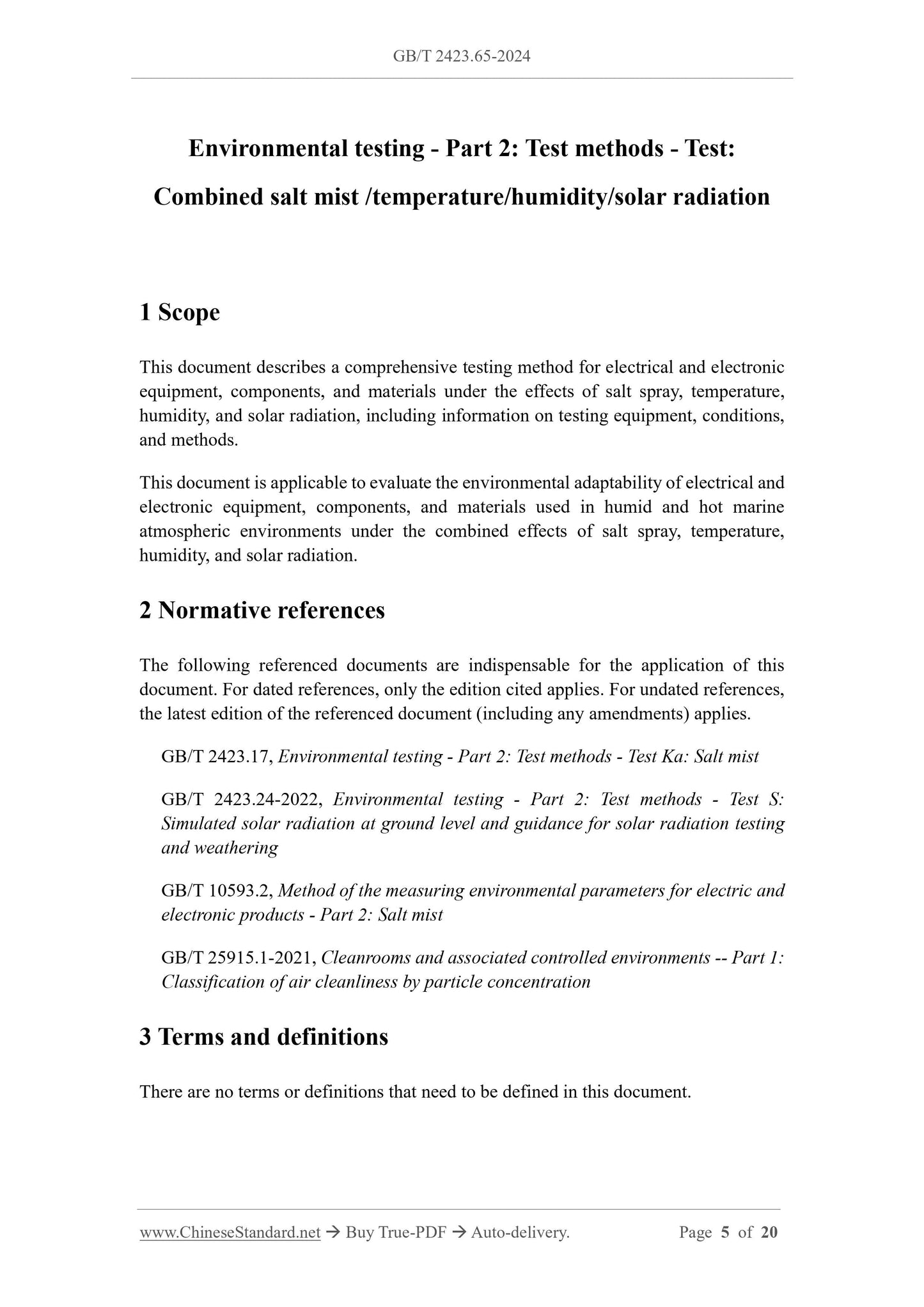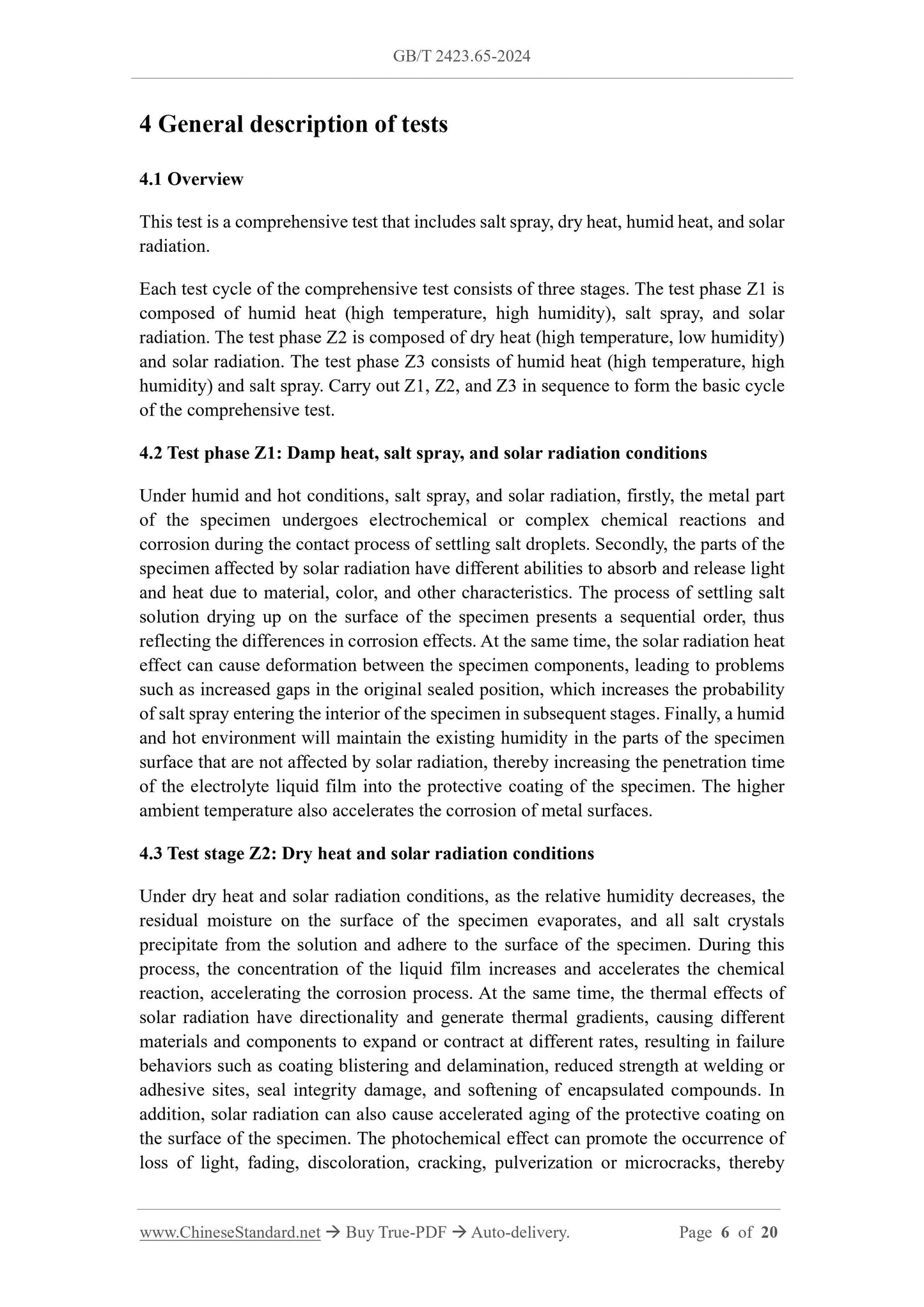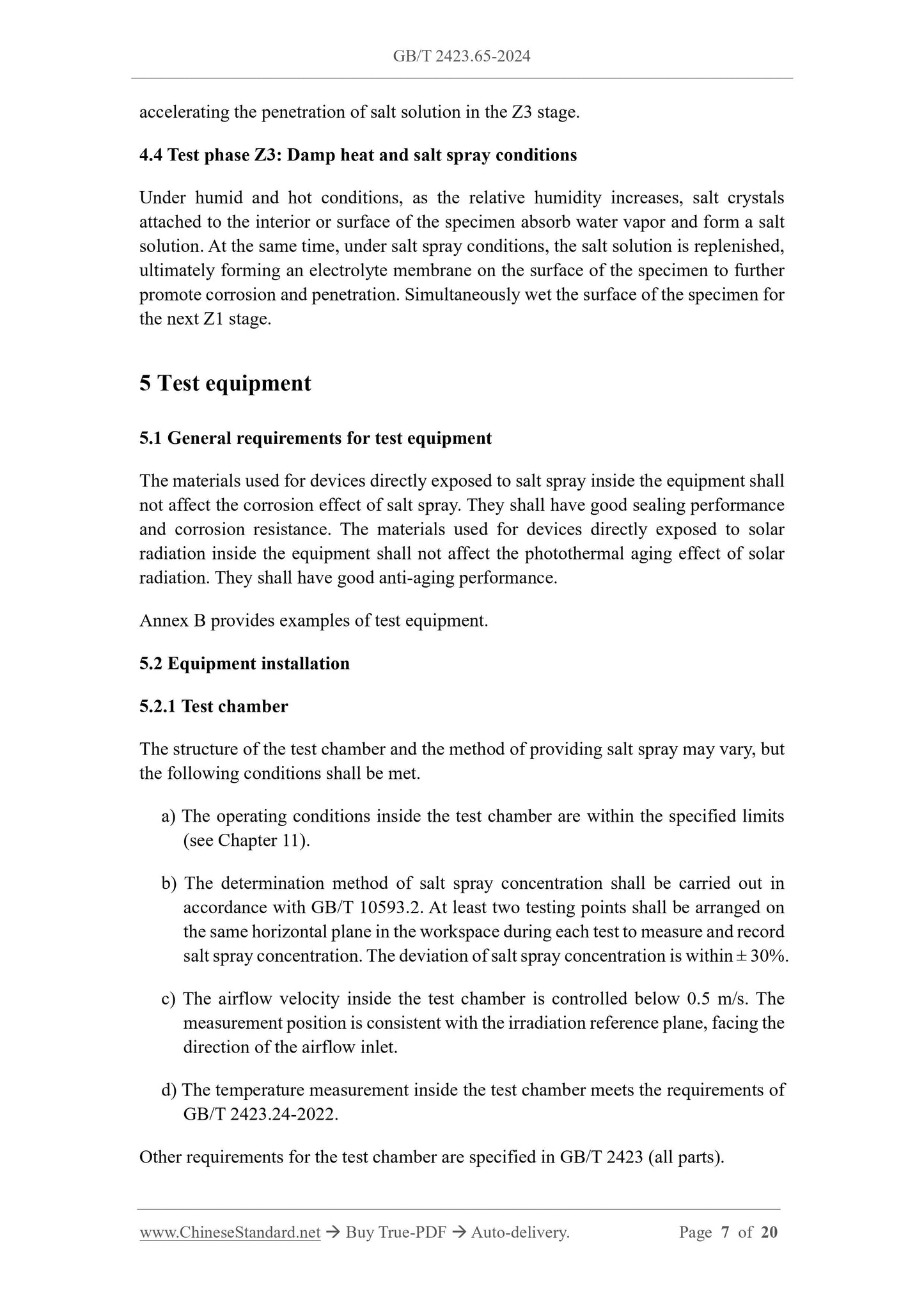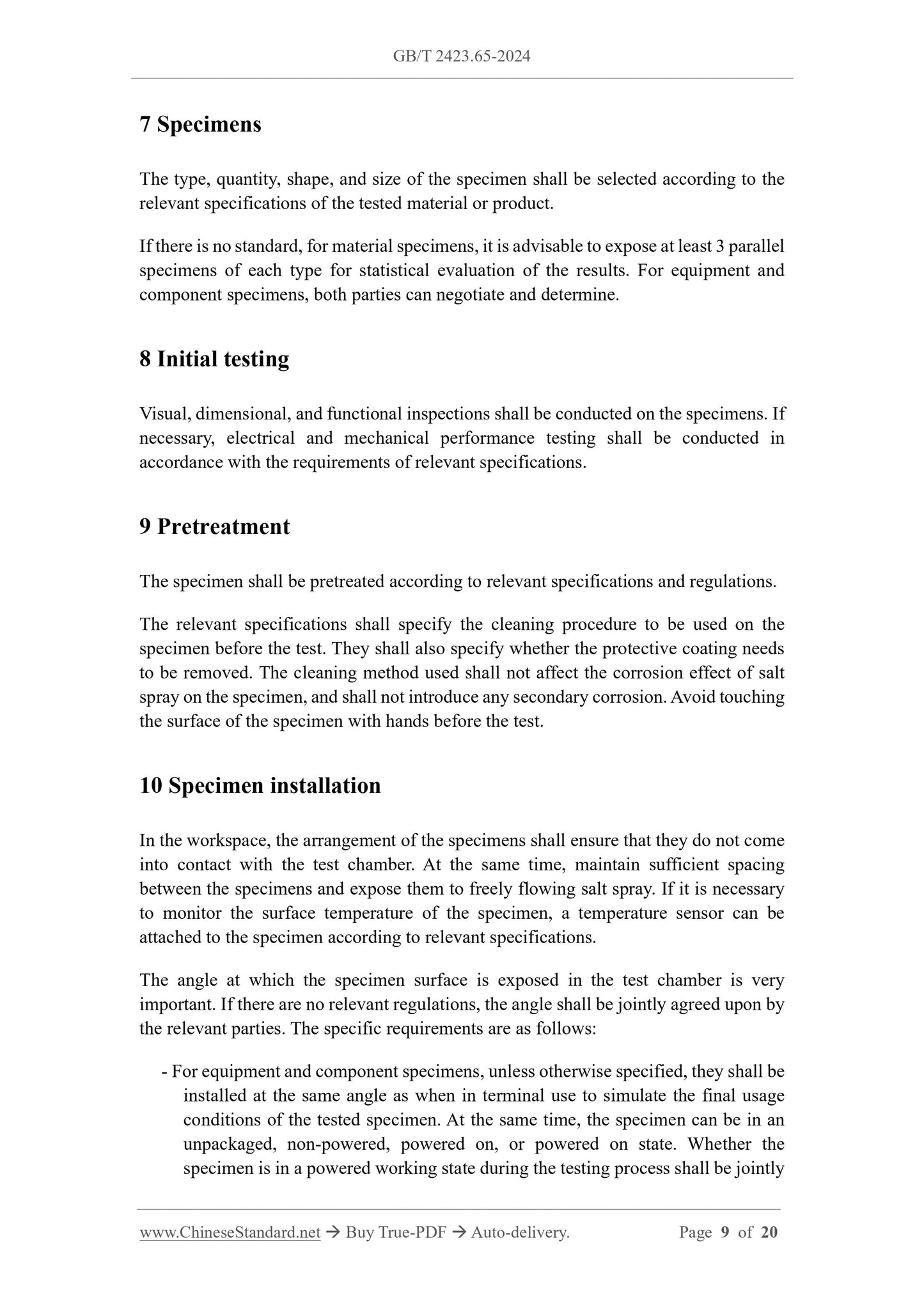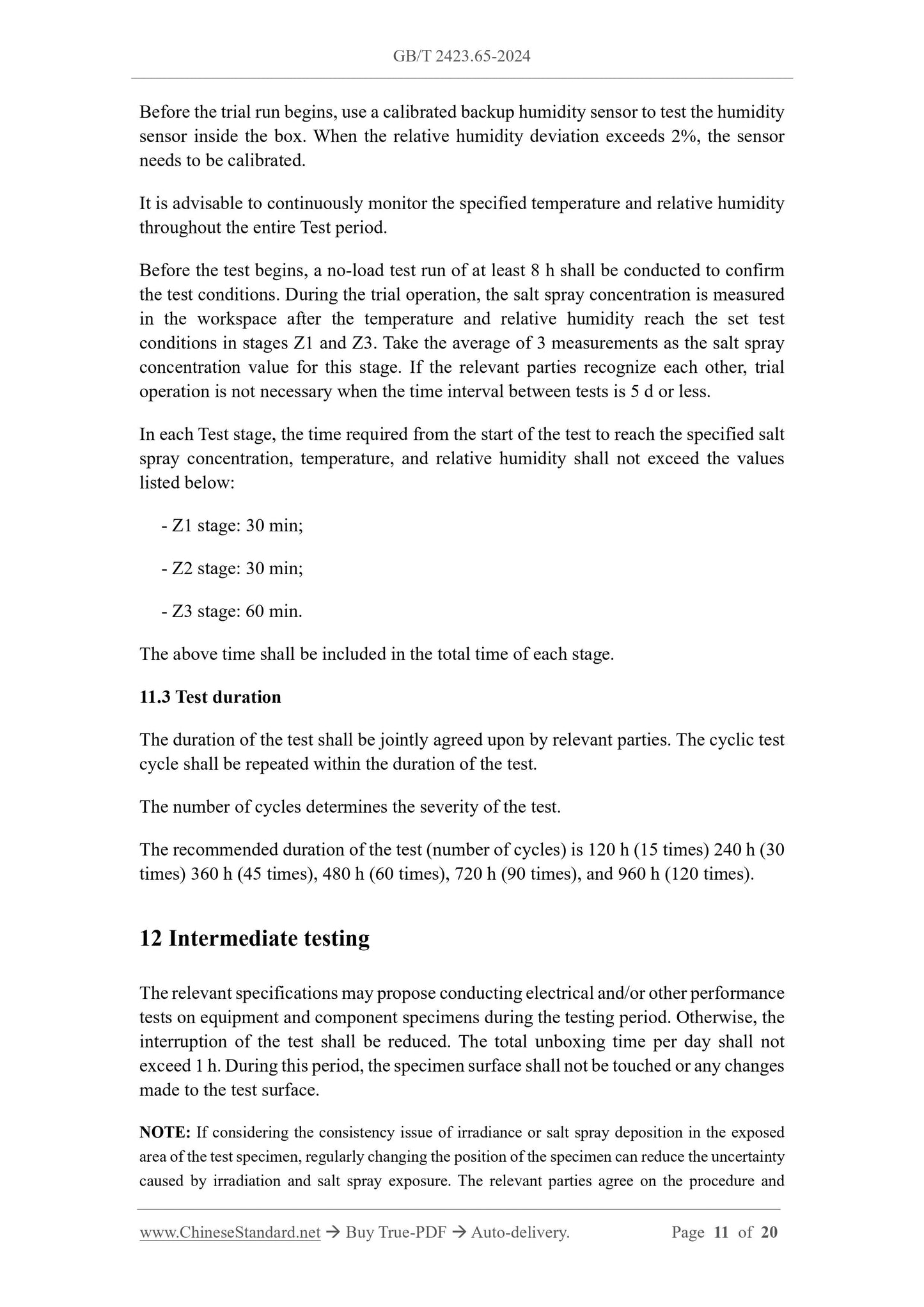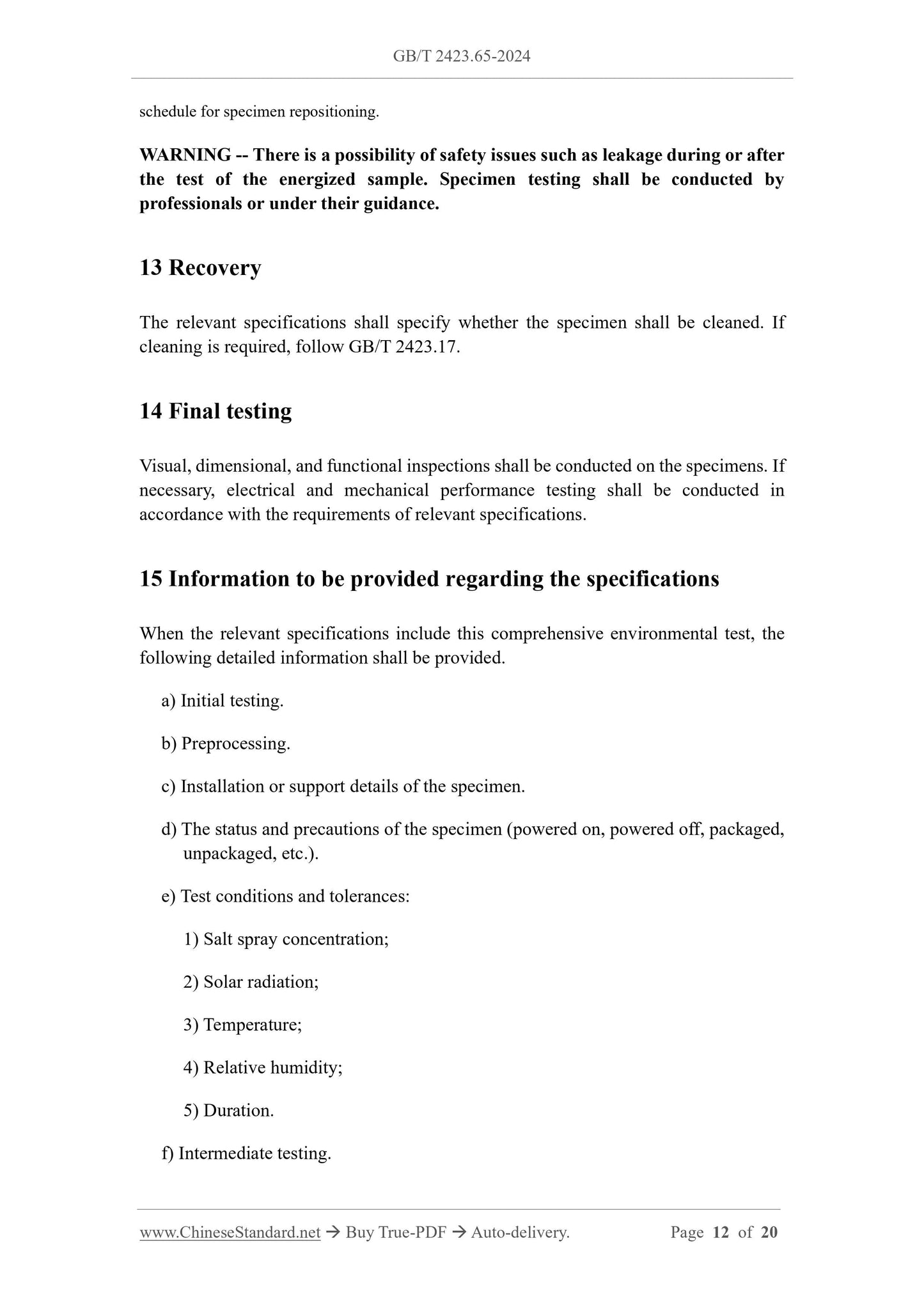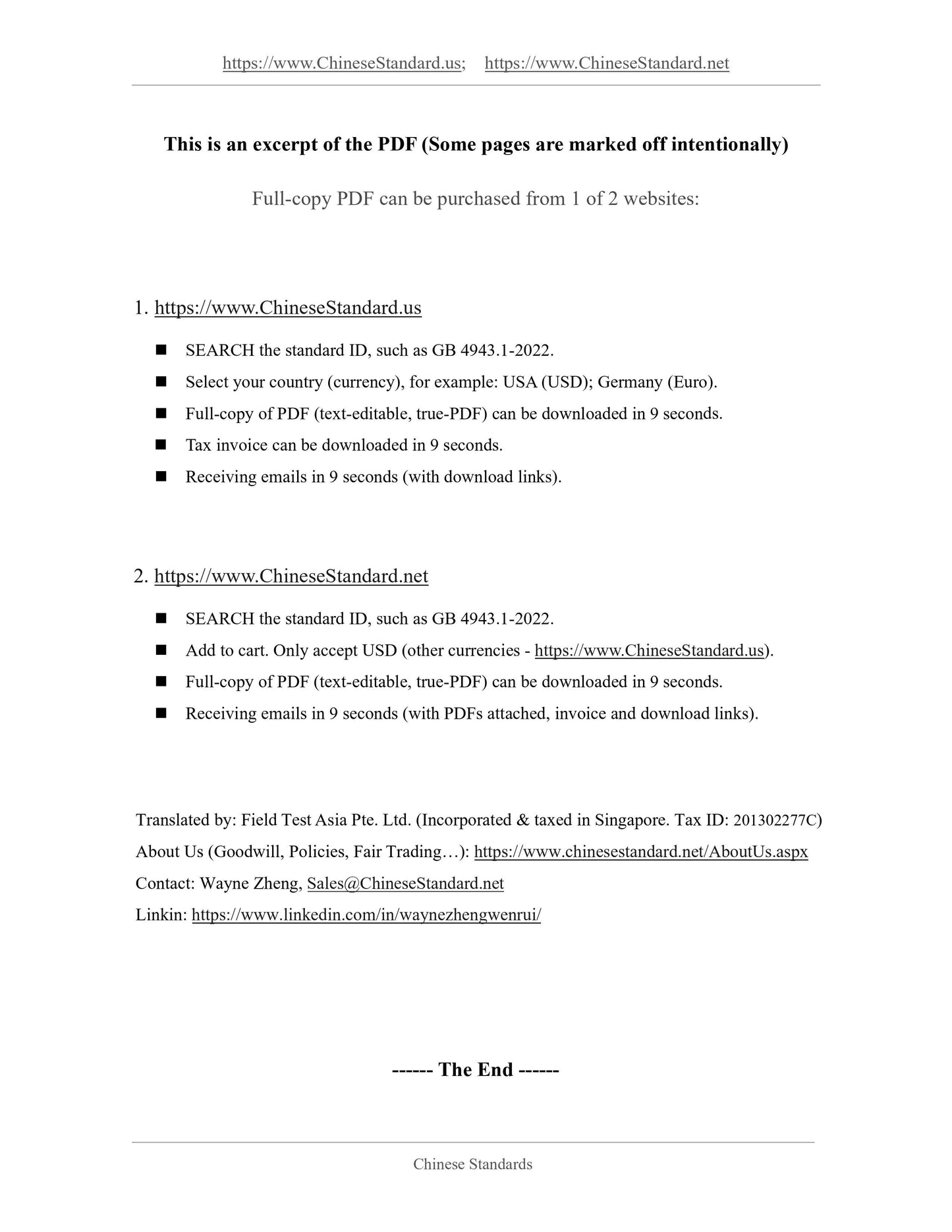1
/
of
9
www.ChineseStandard.us -- Field Test Asia Pte. Ltd.
GB/T 2423.65-2024 English PDF (GB/T2423.65-2024)
GB/T 2423.65-2024 English PDF (GB/T2423.65-2024)
Regular price
$320.00
Regular price
Sale price
$320.00
Unit price
/
per
Shipping calculated at checkout.
Couldn't load pickup availability
GB/T 2423.65-2024: Environmental testing - Part 2: Test methods - Test: Combined salt mist/temperature/humidity/solar radiation
Delivery: 9 seconds. Download (& Email) true-PDF + Invoice.
Get Quotation: Click GB/T 2423.65-2024 (Self-service in 1-minute)
Historical versions (Master-website): GB/T 2423.65-2024
Preview True-PDF (Reload/Scroll-down if blank)
GB/T 2423.65-2024
GB
NATIONAL STANDARD OF THE
PEOPLE’S REPUBLIC OF CHINA
ICS 19.040
CCS K 04
Environmental testing - Part 2.Test methods - Test.
Combined salt mist /temperature/humidity/solar radiation
综合
ISSUED ON. AUGUST 23, 2024
IMPLEMENTED ON. MARCH 01, 2025
Issued by. State Administration for Market Regulation;
Standardization Administration of the People's Republic of China.
Table of Contents
Foreword... 3
Introduction... 4
1 Scope... 5
2 Normative references... 5
3 Terms and definitions... 5
4 General description of tests... 6
5 Test equipment... 7
6 Salt solution... 8
7 Specimens... 9
8 Initial testing... 9
9 Pretreatment... 9
10 Specimen installation... 9
11 Tests... 10
12 Intermediate testing... 11
13 Recovery... 12
14 Final testing... 12
15 Information to be provided regarding the specifications... 12
16 Test report... 13
Annex A (informative) Composition of GB/T 2423... 14
Annex B (informative) Examples of test equipment... 18
Bibliography... 20
Environmental testing - Part 2.Test methods - Test.
Combined salt mist /temperature/humidity/solar radiation
1 Scope
This document describes a comprehensive testing method for electrical and electronic
equipment, components, and materials under the effects of salt spray, temperature,
humidity, and solar radiation, including information on testing equipment, conditions,
and methods.
This document is applicable to evaluate the environmental adaptability of electrical and
electronic equipment, components, and materials used in humid and hot marine
atmospheric environments under the combined effects of salt spray, temperature,
humidity, and solar radiation.
2 Normative references
The following referenced documents are indispensable for the application of this
document. For dated references, only the edition cited applies. For undated references,
the latest edition of the referenced document (including any amendments) applies.
GB/T 2423.17, Environmental testing - Part 2.Test methods - Test Ka. Salt mist
GB/T 2423.24-2022, Environmental testing - Part 2.Test methods - Test S.
Simulated solar radiation at ground level and guidance for solar radiation testing
and weathering
GB/T 10593.2, Method of the measuring environmental parameters for electric and
electronic products - Part 2.Salt mist
GB/T 25915.1-2021, Cleanrooms and associated controlled environments -- Part 1.
Classification of air cleanliness by particle concentration
3 Terms and definitions
There are no terms or definitions that need to be defined in this document.
4 General description of tests
4.1 Overview
This test is a comprehensive test that includes salt spray, dry heat, humid heat, and solar
radiation.
Each test cycle of the comprehensive test consists of three stages. The test phase Z1 is
composed of humid heat (high temperature, high humidity), salt spray, and solar
radiation. The test phase Z2 is composed of dry heat (high temperature, low humidity)
and solar radiation. The test phase Z3 consists of humid heat (high temperature, high
humidity) and salt spray. Carry out Z1, Z2, and Z3 in sequence to form the basic cycle
of the comprehensive test.
4.2 Test phase Z1.Damp heat, salt spray, and solar radiation conditions
Under humid and hot conditions, salt spray, and solar radiation, firstly, the metal part
of the specimen undergoes electrochemical or complex chemical reactions and
corrosion during the contact process of settling salt droplets. Secondly, the parts of the
specimen affected by solar radiation have different abilities to absorb and release light
and heat due to material, color, and other characteristics. The process of settling salt
solution drying up on the surface of the specimen presents a sequential order, thus
reflecting the differences in corrosion effects. At the same time, the solar radiation heat
effect can cause deformation between the specimen components, leading to problems
such as increased gaps in the original sealed position, which increases the probability
of salt spray entering the interior of the specimen in subsequent stages. Finally, a humid
and hot environment will maintain the existing humidity in the parts of the specimen
surface that are not affected by solar radiation, thereby increasing the penetration time
of the electrolyte liquid film into the protective coating of the specimen. The higher
ambient temperature also accelerates the corrosion of metal surfaces.
4.3 Test stage Z2.Dry heat and solar radiation conditions
Under dry heat and solar radiation conditions, as the relative humidity decreases, the
residual moisture on the surface of the specimen evaporates, and all salt crystals
precipitate from the solution and adhere to the surface of the specimen. During this
process, the concentration of the liquid film increases and accelerates the chemical
reaction, accelerating the corrosion process. At the same time, the thermal effects of
solar radiation have directionality and generate thermal gradients, causing different
materials and components to expand or contract at different rates, resulting in failure
behaviors such as coating blistering and delamination, reduced strength at welding or
adhesive sites, seal integrity damage, and softening of encapsulated compounds. In
addition, solar radiation can also cause accelerated aging of the protective coating on
the surface of the specimen. The photochemical effect can promote the occurrence of
loss of light, fading, discoloration, cracking, pulverization or microcracks, thereby
accelerating the penetration of salt solution in the Z3 stage.
4.4 Test phase Z3.Damp heat and salt spray conditions
Under humid and hot conditions, as the relative humidity increases, salt crystals
attached to the interior or surface of the specimen absorb water vapor and form a salt
solution. At the same time, under salt spray conditions, the salt solution is replenished,
ultimately forming an electrolyte membrane on the surface of the specimen to further
promote corrosion and penetration. Simultaneously wet the surface of the specimen for
the next Z1 stage.
5 Test equipment
5.1 General requirements for test equipment
The materials used for devices directly exposed to salt spray inside the equipment shall
not affect the corrosion effect of salt spray. They shall have good sealing performance
and corrosion resistance. The materials used for devices directly exposed to solar
radiation inside the equipment shall not affect the photothermal aging effect of solar
radiation. They shall have good anti-aging performance.
Annex B provides examples of test equipment.
5.2 Equipment installation
5.2.1 Test chamber
The structure of the test chamber and the method of providing salt spray may vary, but
the following conditions shall be met.
a) The operating conditions inside the test chamber are within the specified limits
(see Chapter 11).
b) The determination method of salt spray concentration shall be carried out in
accordance with GB/T 10593.2.At least two testing points shall be arranged on
the same horizontal plane in the workspace during each test to measure and record
salt spray concentration. The deviation of salt spray concentration is within ± 30%.
c) The airflow velocity inside the test chamber is controlled below 0.5 m/s. The
measurement position is consistent with the irradiation reference plane, facing the
direction of the airflow inlet.
d) The temperature measurement inside the test chamber meets the requirements of
GB/T 2423.24-2022.
Other requirements for the test chamber are specified in GB/T 2423 (all parts).
7 Specimens
The type, quantity, shape, and size of the specimen shall be selected according to the
relevant specifications of the tested material or product.
If there is no standard, for material specimens, it is advisable to expose at least 3 parallel
specimens of each type for statistical evaluation of the results. For equipment and
component specimens, both parties can negotiate and determine.
8 Initial testing
Visual, dimensional, and functional inspections shall be conducted on the specimens. If
necessary, electrical and mechanical performance testing shall be conducted in
accordance with the requirements of relevant specifications.
9 Pretreatment
The specimen shall be pretreated according to relevant specifications and regulations.
The relevant specifications shall specify the cleaning procedure to be used on the
specimen before the test. They shall also specify whether the protective coating needs
to be removed. The cleaning method used shall not affect the corrosion effect of salt
spray on the specimen, and shall not introduce any secondary corrosion. Avoid touching
the surface of the specimen with hands before the test.
10 Specimen installation
In the workspace, the arrangement of the specimens shall ensure that they do not come
into contact with the test chamber. At the same time, maintain sufficient spacing
between the specimens and expose them to freely flowing salt spray. If it is necessary
to monitor the surface temperature of the specimen, a temperature sensor can be
attached to the specimen according to relevant specifications.
The angle at which the specimen surface is exposed in the test chamber is very
important. If there are no relevant regulations, the angle shall be jointly agreed upon by
the relevant parties. The specific requirements are as follows.
- For equipment and component specimens, unless otherwise specified, they shall be
installed at the same angle as when in terminal use to simulate the final usage
conditions of the tested specimen. At the same time, the specimen can be in an
unpackaged, non-powered, powered on, or powered on state. Whether the
specimen is in a powered working state during the testing process shall be jointly
Before the trial run begins, use a calibrated backup humidity sensor to test the humidity
sensor inside the box. When the relative humidity deviation exceeds 2%, the sensor
needs to be calibrated.
It is advisable to continuously monitor the specified temperature and relative humidity
throughout the entire Test period.
Before the test begins, a no-load test run of at least 8 h shall be conducted to confirm
the test conditions. During the trial operation, the salt spray concentration is measured
in the workspace after the temperature and relative humidity reach the set test
conditions in stages Z1 and Z3.Take the average of 3 measurements as the salt spray
concentration value for this stage. If the relevant parties recognize each other, trial
operation is not necessary when the time interval between tests is 5 d or less.
In each Test stage, the time required from the start of the test to reach the specified salt
spray concentration, temperature, and relative humidity shall not exceed the values
listed below.
- Z1 stage. 30 min;
- Z2 stage. 30 min;
- Z3 stage. 60 min.
The above time shall be included in the total time of each stage.
11.3 Test duration
The duration of the test shall be jointly agreed upon by relevant parties. The cyclic test
cycle shall be repeated within the duration of the test.
The number of cycles determines the severity of the test.
The recommended duration of the test (number of cycles) is 120 h (15 times) 240 h (30
times) 360 h (45 times), 480 h (60 times), 720 h (90 times), and 960 h (120 times).
12 Intermediate testing
The relevant specifications may propose conducting electrical and/or other performance
tests on equipment and component specimens during the testing period. Otherwise, the
interruption of the test shall be reduced. The total unboxing time per day shall not
exceed 1 h. During this period, the specimen surface shall not be touched or any changes
made to the test surface.
NOTE. If considering the consistency issue of irradiance or salt spray deposition in the exposed
area of the test specimen, regularly changing the position of the specimen can reduce the uncertainty
caused by irradiation and salt spray exposure. The relevant parties agree on the procedure and
schedule for specimen repositioning.
WARNING -- There is a possibility of safety issues such as leakage during or after
the test of the energized sample. Specimen testing shall be conducted by
professionals or under their guidance.
13 Recovery
The relevant specifications shall specify whether the specimen shall be cleaned. If
cleaning is required, follow GB/T 2423.17.
14 Final testing
Visual, dimensional, and functional inspections shall be conducted on the specimens. If
necessary, electrical and mechanical performance testing shall be conducted in
accordance with the requirements of relevant specifications.
15 Information to be provided regarding the specifications
When the relevant specifications include this comprehensive environmental test, the
following detailed information shall be provided.
a) Initial testing.
b) Preprocessing.
c) Installation or support details of the specimen.
d) The status and precautions of the specimen (powered on, powered off, packaged,
unpackaged, etc.).
e) Test conditions and tolerances.
1) Salt spray concentration;
2) Solar radiation;
3) Temperature;
4) Relative humidity;
5) Duration.
f) Intermediate testing.
GB/T 2423.65-2024
GB
NATIONAL STANDARD OF THE
PEOPLE’S REPUBLIC OF CHINA
ICS 19.040
CCS K 04
Environmental testing - Part 2.Test methods - Test.
Combined salt mist /temperature/humidity/solar radiation
综合
ISSUED ON. AUGUST 23, 2024
IMPLEMENTED ON. MARCH 01, 2025
Issued by. State Administration for Market Regulation;
Standardization Administration of the People's Republic of China.
Table of Contents
Foreword... 3
Introduction... 4
1 Scope... 5
2 Normative references... 5
3 Terms and definitions... 5
4 General description of tests... 6
5 Test equipment... 7
6 Salt solution... 8
7 Specimens... 9
8 Initial testing... 9
9 Pretreatment... 9
10 Spec...
Delivery: 9 seconds. Download (& Email) true-PDF + Invoice.
Get Quotation: Click GB/T 2423.65-2024 (Self-service in 1-minute)
Historical versions (Master-website): GB/T 2423.65-2024
Preview True-PDF (Reload/Scroll-down if blank)
GB/T 2423.65-2024
GB
NATIONAL STANDARD OF THE
PEOPLE’S REPUBLIC OF CHINA
ICS 19.040
CCS K 04
Environmental testing - Part 2.Test methods - Test.
Combined salt mist /temperature/humidity/solar radiation
综合
ISSUED ON. AUGUST 23, 2024
IMPLEMENTED ON. MARCH 01, 2025
Issued by. State Administration for Market Regulation;
Standardization Administration of the People's Republic of China.
Table of Contents
Foreword... 3
Introduction... 4
1 Scope... 5
2 Normative references... 5
3 Terms and definitions... 5
4 General description of tests... 6
5 Test equipment... 7
6 Salt solution... 8
7 Specimens... 9
8 Initial testing... 9
9 Pretreatment... 9
10 Specimen installation... 9
11 Tests... 10
12 Intermediate testing... 11
13 Recovery... 12
14 Final testing... 12
15 Information to be provided regarding the specifications... 12
16 Test report... 13
Annex A (informative) Composition of GB/T 2423... 14
Annex B (informative) Examples of test equipment... 18
Bibliography... 20
Environmental testing - Part 2.Test methods - Test.
Combined salt mist /temperature/humidity/solar radiation
1 Scope
This document describes a comprehensive testing method for electrical and electronic
equipment, components, and materials under the effects of salt spray, temperature,
humidity, and solar radiation, including information on testing equipment, conditions,
and methods.
This document is applicable to evaluate the environmental adaptability of electrical and
electronic equipment, components, and materials used in humid and hot marine
atmospheric environments under the combined effects of salt spray, temperature,
humidity, and solar radiation.
2 Normative references
The following referenced documents are indispensable for the application of this
document. For dated references, only the edition cited applies. For undated references,
the latest edition of the referenced document (including any amendments) applies.
GB/T 2423.17, Environmental testing - Part 2.Test methods - Test Ka. Salt mist
GB/T 2423.24-2022, Environmental testing - Part 2.Test methods - Test S.
Simulated solar radiation at ground level and guidance for solar radiation testing
and weathering
GB/T 10593.2, Method of the measuring environmental parameters for electric and
electronic products - Part 2.Salt mist
GB/T 25915.1-2021, Cleanrooms and associated controlled environments -- Part 1.
Classification of air cleanliness by particle concentration
3 Terms and definitions
There are no terms or definitions that need to be defined in this document.
4 General description of tests
4.1 Overview
This test is a comprehensive test that includes salt spray, dry heat, humid heat, and solar
radiation.
Each test cycle of the comprehensive test consists of three stages. The test phase Z1 is
composed of humid heat (high temperature, high humidity), salt spray, and solar
radiation. The test phase Z2 is composed of dry heat (high temperature, low humidity)
and solar radiation. The test phase Z3 consists of humid heat (high temperature, high
humidity) and salt spray. Carry out Z1, Z2, and Z3 in sequence to form the basic cycle
of the comprehensive test.
4.2 Test phase Z1.Damp heat, salt spray, and solar radiation conditions
Under humid and hot conditions, salt spray, and solar radiation, firstly, the metal part
of the specimen undergoes electrochemical or complex chemical reactions and
corrosion during the contact process of settling salt droplets. Secondly, the parts of the
specimen affected by solar radiation have different abilities to absorb and release light
and heat due to material, color, and other characteristics. The process of settling salt
solution drying up on the surface of the specimen presents a sequential order, thus
reflecting the differences in corrosion effects. At the same time, the solar radiation heat
effect can cause deformation between the specimen components, leading to problems
such as increased gaps in the original sealed position, which increases the probability
of salt spray entering the interior of the specimen in subsequent stages. Finally, a humid
and hot environment will maintain the existing humidity in the parts of the specimen
surface that are not affected by solar radiation, thereby increasing the penetration time
of the electrolyte liquid film into the protective coating of the specimen. The higher
ambient temperature also accelerates the corrosion of metal surfaces.
4.3 Test stage Z2.Dry heat and solar radiation conditions
Under dry heat and solar radiation conditions, as the relative humidity decreases, the
residual moisture on the surface of the specimen evaporates, and all salt crystals
precipitate from the solution and adhere to the surface of the specimen. During this
process, the concentration of the liquid film increases and accelerates the chemical
reaction, accelerating the corrosion process. At the same time, the thermal effects of
solar radiation have directionality and generate thermal gradients, causing different
materials and components to expand or contract at different rates, resulting in failure
behaviors such as coating blistering and delamination, reduced strength at welding or
adhesive sites, seal integrity damage, and softening of encapsulated compounds. In
addition, solar radiation can also cause accelerated aging of the protective coating on
the surface of the specimen. The photochemical effect can promote the occurrence of
loss of light, fading, discoloration, cracking, pulverization or microcracks, thereby
accelerating the penetration of salt solution in the Z3 stage.
4.4 Test phase Z3.Damp heat and salt spray conditions
Under humid and hot conditions, as the relative humidity increases, salt crystals
attached to the interior or surface of the specimen absorb water vapor and form a salt
solution. At the same time, under salt spray conditions, the salt solution is replenished,
ultimately forming an electrolyte membrane on the surface of the specimen to further
promote corrosion and penetration. Simultaneously wet the surface of the specimen for
the next Z1 stage.
5 Test equipment
5.1 General requirements for test equipment
The materials used for devices directly exposed to salt spray inside the equipment shall
not affect the corrosion effect of salt spray. They shall have good sealing performance
and corrosion resistance. The materials used for devices directly exposed to solar
radiation inside the equipment shall not affect the photothermal aging effect of solar
radiation. They shall have good anti-aging performance.
Annex B provides examples of test equipment.
5.2 Equipment installation
5.2.1 Test chamber
The structure of the test chamber and the method of providing salt spray may vary, but
the following conditions shall be met.
a) The operating conditions inside the test chamber are within the specified limits
(see Chapter 11).
b) The determination method of salt spray concentration shall be carried out in
accordance with GB/T 10593.2.At least two testing points shall be arranged on
the same horizontal plane in the workspace during each test to measure and record
salt spray concentration. The deviation of salt spray concentration is within ± 30%.
c) The airflow velocity inside the test chamber is controlled below 0.5 m/s. The
measurement position is consistent with the irradiation reference plane, facing the
direction of the airflow inlet.
d) The temperature measurement inside the test chamber meets the requirements of
GB/T 2423.24-2022.
Other requirements for the test chamber are specified in GB/T 2423 (all parts).
7 Specimens
The type, quantity, shape, and size of the specimen shall be selected according to the
relevant specifications of the tested material or product.
If there is no standard, for material specimens, it is advisable to expose at least 3 parallel
specimens of each type for statistical evaluation of the results. For equipment and
component specimens, both parties can negotiate and determine.
8 Initial testing
Visual, dimensional, and functional inspections shall be conducted on the specimens. If
necessary, electrical and mechanical performance testing shall be conducted in
accordance with the requirements of relevant specifications.
9 Pretreatment
The specimen shall be pretreated according to relevant specifications and regulations.
The relevant specifications shall specify the cleaning procedure to be used on the
specimen before the test. They shall also specify whether the protective coating needs
to be removed. The cleaning method used shall not affect the corrosion effect of salt
spray on the specimen, and shall not introduce any secondary corrosion. Avoid touching
the surface of the specimen with hands before the test.
10 Specimen installation
In the workspace, the arrangement of the specimens shall ensure that they do not come
into contact with the test chamber. At the same time, maintain sufficient spacing
between the specimens and expose them to freely flowing salt spray. If it is necessary
to monitor the surface temperature of the specimen, a temperature sensor can be
attached to the specimen according to relevant specifications.
The angle at which the specimen surface is exposed in the test chamber is very
important. If there are no relevant regulations, the angle shall be jointly agreed upon by
the relevant parties. The specific requirements are as follows.
- For equipment and component specimens, unless otherwise specified, they shall be
installed at the same angle as when in terminal use to simulate the final usage
conditions of the tested specimen. At the same time, the specimen can be in an
unpackaged, non-powered, powered on, or powered on state. Whether the
specimen is in a powered working state during the testing process shall be jointly
Before the trial run begins, use a calibrated backup humidity sensor to test the humidity
sensor inside the box. When the relative humidity deviation exceeds 2%, the sensor
needs to be calibrated.
It is advisable to continuously monitor the specified temperature and relative humidity
throughout the entire Test period.
Before the test begins, a no-load test run of at least 8 h shall be conducted to confirm
the test conditions. During the trial operation, the salt spray concentration is measured
in the workspace after the temperature and relative humidity reach the set test
conditions in stages Z1 and Z3.Take the average of 3 measurements as the salt spray
concentration value for this stage. If the relevant parties recognize each other, trial
operation is not necessary when the time interval between tests is 5 d or less.
In each Test stage, the time required from the start of the test to reach the specified salt
spray concentration, temperature, and relative humidity shall not exceed the values
listed below.
- Z1 stage. 30 min;
- Z2 stage. 30 min;
- Z3 stage. 60 min.
The above time shall be included in the total time of each stage.
11.3 Test duration
The duration of the test shall be jointly agreed upon by relevant parties. The cyclic test
cycle shall be repeated within the duration of the test.
The number of cycles determines the severity of the test.
The recommended duration of the test (number of cycles) is 120 h (15 times) 240 h (30
times) 360 h (45 times), 480 h (60 times), 720 h (90 times), and 960 h (120 times).
12 Intermediate testing
The relevant specifications may propose conducting electrical and/or other performance
tests on equipment and component specimens during the testing period. Otherwise, the
interruption of the test shall be reduced. The total unboxing time per day shall not
exceed 1 h. During this period, the specimen surface shall not be touched or any changes
made to the test surface.
NOTE. If considering the consistency issue of irradiance or salt spray deposition in the exposed
area of the test specimen, regularly changing the position of the specimen can reduce the uncertainty
caused by irradiation and salt spray exposure. The relevant parties agree on the procedure and
schedule for specimen repositioning.
WARNING -- There is a possibility of safety issues such as leakage during or after
the test of the energized sample. Specimen testing shall be conducted by
professionals or under their guidance.
13 Recovery
The relevant specifications shall specify whether the specimen shall be cleaned. If
cleaning is required, follow GB/T 2423.17.
14 Final testing
Visual, dimensional, and functional inspections shall be conducted on the specimens. If
necessary, electrical and mechanical performance testing shall be conducted in
accordance with the requirements of relevant specifications.
15 Information to be provided regarding the specifications
When the relevant specifications include this comprehensive environmental test, the
following detailed information shall be provided.
a) Initial testing.
b) Preprocessing.
c) Installation or support details of the specimen.
d) The status and precautions of the specimen (powered on, powered off, packaged,
unpackaged, etc.).
e) Test conditions and tolerances.
1) Salt spray concentration;
2) Solar radiation;
3) Temperature;
4) Relative humidity;
5) Duration.
f) Intermediate testing.
GB/T 2423.65-2024
GB
NATIONAL STANDARD OF THE
PEOPLE’S REPUBLIC OF CHINA
ICS 19.040
CCS K 04
Environmental testing - Part 2.Test methods - Test.
Combined salt mist /temperature/humidity/solar radiation
综合
ISSUED ON. AUGUST 23, 2024
IMPLEMENTED ON. MARCH 01, 2025
Issued by. State Administration for Market Regulation;
Standardization Administration of the People's Republic of China.
Table of Contents
Foreword... 3
Introduction... 4
1 Scope... 5
2 Normative references... 5
3 Terms and definitions... 5
4 General description of tests... 6
5 Test equipment... 7
6 Salt solution... 8
7 Specimens... 9
8 Initial testing... 9
9 Pretreatment... 9
10 Spec...
Share
